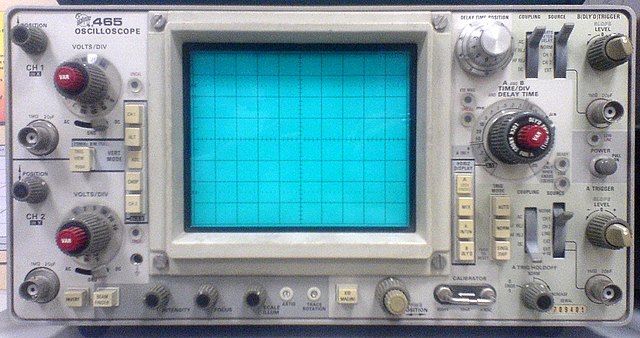A Vectorscope is a special type of oscilloscope used in both audio and video applications. Whereas an oscilloscope or waveform monitor normally displays a plot of signal vs. time, a vectorscope displays an X-Y plot of two signals, which can reveal details about the relationship between these two signals. Vectorscopes are highly similar in operation to oscilloscopes operated in X-Y mode; however those used in video applications have specialized graticules, and accept standard television or video signals as input.
A video vectorscope displaying color bars. The diagonal direction of the color burst vector is indicative of a PAL signal.
An oscilloscope is a type of electronic test instrument that graphically displays varying voltages of one or more signals as a function of time. Their main purpose is capturing information on electrical signals for debugging, analysis, or characterization. The displayed waveform can then be analyzed for properties such as amplitude, frequency, rise time, time interval, distortion, and others. Originally, calculation of these values required manually measuring the waveform against the scales built into the screen of the instrument. Modern digital instruments may calculate and display these properties directly.
A Tektronix model 475A portable analog oscilloscope, a typical instrument of the late 1970s
Oscilloscope cathode-ray tube, the left square-shaped end would be the blue screen in the upper device when built in.
Typical display of an analog oscilloscope measuring a sine wave signal with 10 kHz. From the grid inherent to the screen together with the user-set parameters of the device shown at the upper display rim, the user may calculate the frequency and the voltage of the measured signal. Modern digital oscilloscopes set the measurement parameters and calculate/display the signal values automatically.
Type 465 Tektronix oscilloscope. This was a popular analog oscilloscope, portable, and is a representative example.





